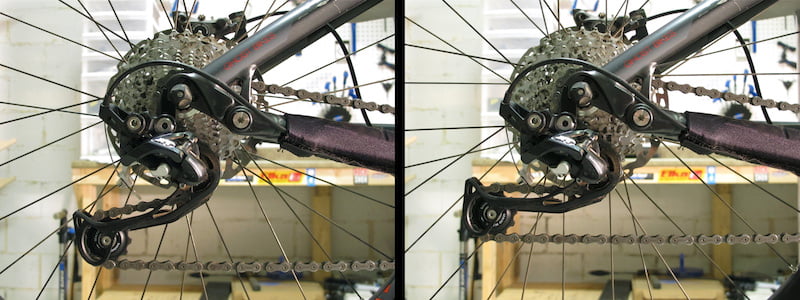

Any suggestions on how to install them? From: Octavio I know that Shimano chains are a little trickier to install with their master pins instead of master links. Recently I got a new bike with Shimano Dura-Ace and after about 1200 miles it is time to change the chain. My old bike that I have been riding for 4 years had SRAM Force and I always changed the chains myself without any hassle using their Power Links. Make your chain the right length and you won’t long for another one. This will allow for chain growth due to suspension articulation as well as accounting for the increased chain tension experienced during shifting when the chain is not fully engaged with the teeth of your chosen cog or chainring. Then subtract one link from the portion you have determined to remove so that the shortened chain is one link longer than it needs to be. Then pull the chain tight and make the chain as short as it can be but still be able to be joined and mark or make a mental note how many links need to be removed. Place the new chain on these largest gears and feed it through the derailleur and a chain guide if you are using one. Start by removing the old chain and then shifting into the big chainring and the largest cog. On a mountain bike you want the chain to be as short as possible to prevent chain slap and dropped chains. Literally!įor mountain bikes the process is nearly the opposite.

SRAM’s power links make installation a snap. The same goes for SRAM chains that do use a master link and will need to be a half-link shorter than a Shimano chain. Keep in mind that if it is a Shimano chain there is no master link so you need to take this into account in your measurements. Essentially, you are trying to make the chain as long as possible without the chain dragging on the derailleur or sagging because the derailleur can’t pull it taught. Pull the ends together until the chain no longer drags on the derailleur cage and mark or take a mental note how many links have to be removed in order to have a joined chain that puts the derailleur cage in this position.

This is the gear combo that you will need to be in to determine the right chain length and will ensure that there is no unnecessary drag on the drivetrain when you are in the big ring and at the larger end of the cassette.Īfter removing the old chain with the proper tool, lay the new chain on these smallest gears and feed it through the derailleur so that both ends of the chain are underneath the chainstay. On a road bike you need to shift the bike into the small cog and the small chainring before removing the old chain. As you mentioned you could match the old chain but sometimes that is not an option if you are changing chainrings or cranks, or if you broke the chain and it had to be shortened, etc. Determining the correct chain length is easy. Make your chain the wrong length and you play the fool. Most manufacturers recommend you replace your chain once the gap between the rollers has grown (due to wear) by 0.75%.įollow our guide to see whether your chain is still in fighting shape.Copying your old chain length might not be an option if you are switching to a new crank with different sized rings.Ĭhain, chain, chain. However, change it before its too degraded and you’ll prolonge the life of the other bits of your drivetrain. Let your chain get too worn and your shifting will suffer, along with the state of your chainrings, cassette and jockey wheels. Luckily there are ways to diagnose exactly the state yours is in. Hugely affected by the conditions you ride in, and the amount of cleaning you can be bothered with, its lifespan can be hard to predict. Often referred to as having stretched, the chain’s length will actually remain the same, but its ability to do its job will get less and less until eventually you’ll find your gears slipping. As it does so both its rollers and pins will slowly wear out. Meshing with the teeth of both your chainrings and sprockets, the chain transfers the energy produced by your legs to the rear wheel. However, it's easy to overlook chain wear that can cause serious inefficiency in the drivetrain and even risk a chain failure. There aren't many components more important on a bike than its chain.


 0 kommentar(er)
0 kommentar(er)
